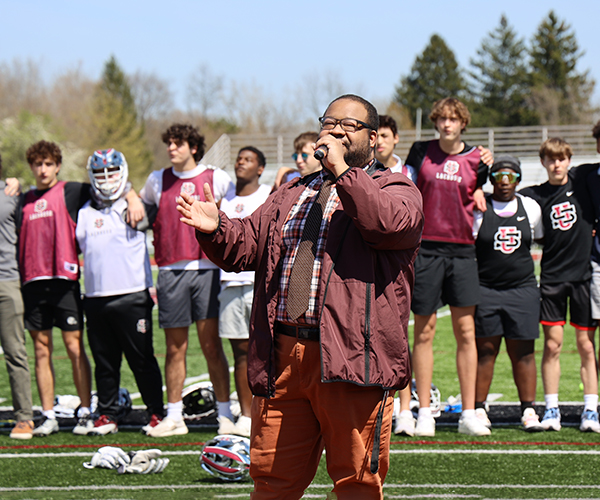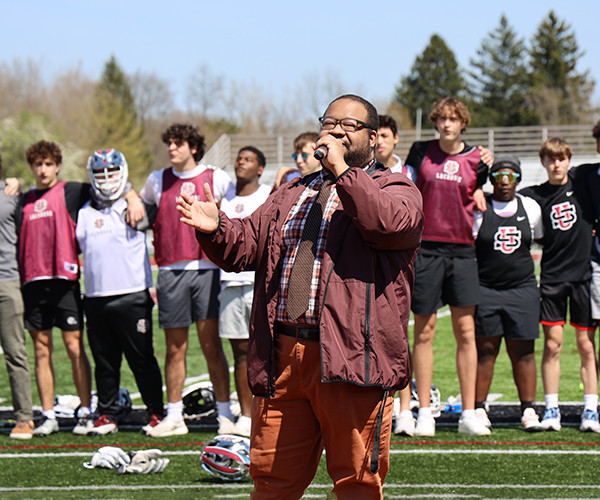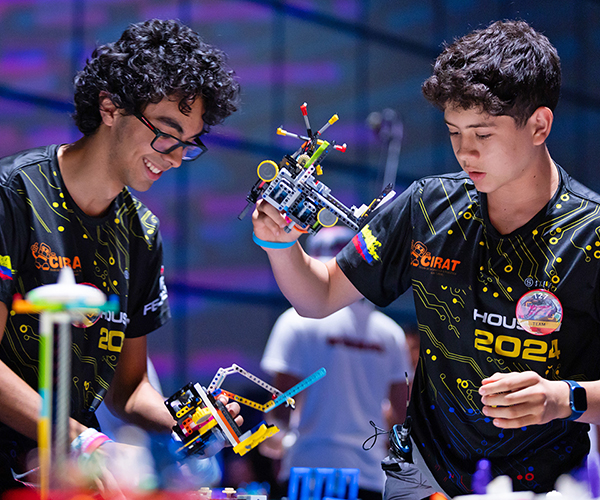At only 12-years-old, Urban Community School's Jouvert Guy-James has already played a role in helping thousands of kids learn computer programming.
The sixth-grader appears in a long peach T-shirt, jeans and aqua sneakers as one of two characters to program into a dance routine on Scratch, a global coding platform developed by the MIT Media Lab. Designed for 8- to 16-year-olds, Scratch allows its 9.5 million users to program their own interactive stories, games and animation, then share them with the online community.
"I have a better understanding of computers since I learned Scratch," says Jouvert, whose project was part of Scratch's hip-hop initiative as part of a partnership with Cleveland's Progressive Arts Alliance. "Now, I think I'll be able to do even more coding."
Top rock and head spin dance moves may seem like an unlikely route to teach kids the fundamentals of computer science, but it's a big part of Scratch's success.
Since its browser-based launch in 2013, Scratch has quickly become one of the leading introductions to coding, creative thinking and logical reasoning being used in classrooms throughout Northeast Ohio.
While job openings in computer programming are projected to hit 1.4 million by 2020, only enough talent exists to fill 30 percent of the positions, emphasizing the need to expose students to coding — the programming of commands that control everything from our cellphones to laptops — at an early age.
As the role of technology in children's everyday lives grows, coding can also be a key to unlocking critical thinking. Students have the power to make work that's meaningful to them and share it with the world.
"The act of expressing yourself goes beyond just coding. It cuts across many disciplines," says Eric Schilling, Scratch's online community manager and a 2012 Cleveland State University graduate. "It's thinking creatively about how you're going to get across an idea. You're reasoning systematically and working collaboratively."
As the push to learn coding continues to gain momentum, schools throughout Northeast Ohio are looking at ways to engage students not only scientifically but also creatively.
•••••
Eddie Evans, the technology integration coach at Moreland Hills Elementary School in the Orange City School District, understands that learning code means picking up new languages.
It's part of why he has pushed for coding in classrooms as early as third grade. His students begin with Scratch and the challenge-based CodeMonkey site before moving to the online coursework provided by Code.org at Moreland Hills Elementary School and Brady Middle School.
Early exposure to coding isn't necessarily about molding students into the next computer programmers, Evans explains. It introduces them to the inner workings of the technology they use every day.
"They live in the digital world morning and night," he says. "This is an important part of understanding how everything around them works."
Students are learning more than how a computer works, they are creating programs from start to finish. From their basic conception of an app or game, they're thinking through the logical steps of implementation, which inevitably includes stumbles along the way.
When one piece of a program's puzzle doesn't quite fit, students test their projects with their peers, receiving feedback and tweaking their commands.
"Coding is open-ended problem-solving," says Evans. "It's about playing games and trying to meet challenges."
Brady Middle School participates in Hour of Code, an annual one-day campaign that encourages kids and teachers to set aside time to learn programming.
Following this year's Hour of Code, a survey of the entire school by Brady's technology integration specialist Jake Miller showed 68 percent of students would definitely pursue activities like coding in their free time.
Orange High School graduate Max Zimon says his Advanced Placement computer science course helped develop his skills in Java before he attended Case Western Reserve University, where he'll receive his bachelor's degree in computer science this year.
"It was definitely a formative experience for me," says Zimon. "Having that knowledge coming in [to college] was really valuable. Anyone on the fence about taking computer classes should be encouraged to try it."
Although many regional schools are making foundational coding education a priority, it's still only offered to 10 percent of students in Ohio.
Ohio only began counting computer science classes toward math and science credits in 2014, making it one of 28 states to do so. In 2013, just 12 states offered this incentive.
But that may be about to change. President Barack Obama announced his Computer Science for All initiative in late January, which calls for budgeting $4 billion for states and $100 million directly for school districts to train computer science teachers, expand access and form partnerships. Obama also wants to engage more governors, mayors and leading educators to expand computer science opportunities.
This year, Strongsville High School began offering an exploratory computer science course. Students have already used Scratch to create virtual pets and simple games like rock, paper, scissors.
"The most rewarding part is watching a kid who's signed up, but they're a little nervous about it," says Strongsville instructor Michelle Barrett. "Then, all of the sudden they're really great at what it's all about."
Even for Padua Franciscan High School, which has had computer science courses for more than a decade, the introduction of coding to younger students has changed their overall philosophy.
While many still think of programming as a solitary activity behind a computer screen, coding teaches valuable 21st-century skills, says Susan Fatica, Pauda computer science department chair and instructor.
"When students work in groups to develop a program, they're constantly bouncing ideas around," says Fatica. "It seems to inspire them to help each other."
Padua dives into coding with lessons in the easily adoptable QBasic language before moving to the more popular C++ and other advanced computing topics.
As a starting point, QBasic sets students on a path that demands exercising logic. "They're really forced to do a lot of critical thinking," Fatica says.
Last year Western Reserve Academy added an AP computer science class in which students created choose-your-own-adventure and maze games in JavaScipt. This month, they expect to take their programming further with the installation of a fabrication lab, which will offer hands-on experience in programming computers to operate tools such as vinyl cutters, 3-D printers and laser cutters.
"The next step for us was to allow computer science to be put into practice," says Matt Gerber, director of information and education technology at Western Reserve Academy. "We learn by doing and by failure. Prototyping is great, because you can do things over and make them better."
Western Reserve Academy instructor Jennifer Nagano hopes the experience gives students a well-rounded perspective that leads to larger conversations about Internet privacy and computer security.
"All citizens should be involved in deciding how technology is used," she says. "If they don't understand, it's going to be a lot harder to make informed and appropriate decisions."
•••••
Retaining computer science talent means creating a direct line from students to Cleveland's growing technology employers.
There are currently an estimated 20,000 computing jobs in Ohio, but that number grows with each new innovation.
"One of the big things we have to do as educators is prepare students not only for the jobs that are out there now, but for what's coming," says David Ternent, a STEM teacher at Stow's Kimpton Middle School.
After Kimpton introduced its science, technology, engineering and mathematics program four years ago, Ternent quickly realized the curriculum needed coding.
In class, Ternent's students use Code Academy, which he likens to the Rosetta Stone of programming, to learn Python, Ruby and JQuery. Others use Unity to learn to code games and create tank battles. This year, Ternent included Microsoft's Visual Studio development software so students could make their own apps and upload them to the App Store, Google Play or Microsoft Store.
Max S. Hayes High School is taking its computer science cues from an advisory panel of professionals from local companies such as Hyland Software, Eaton Corp., Lubrizol and Swagelok. While Max Hayes students typically use Oracle Academy's Web-based Java training program, they began integrating more mobile application development during the second semester. It's a step toward preparing students for what their postsecondary education guides say they need, says Max S. Hayes instructor Todd LeVeck.
"There's a demand for tech professionals, but it's hard for a lot of students to connect to the industry," says LeVeck. "Once we close that gap, we show kids there is a real pathway to a career."
In an attempt to help cross that bridge, Hyland Software launched the Hyland Innovation Showdown in 2013. The annual competition invites high school students to solve business problems using technology.
In 2014, Hyland founded Hy-Tech Camps, where employees lead area middle and high school students in three-hour sessions covering website development, robotics and advanced programming languages. It spawned Hyland's Hy-Tech Club and a three-day hackathon with 55 students.
While Hyland hopes to fill nearly 450 tech positions this year, it can be challenging to find talented applicants. "There's a lot of demand," says Caitlin Nowlin, Hyland technical outreach program manager, "but not a lot of supply in the local area."
In 2009, a collaborative of employers formed the Regional Information Technology Engagement to create a pipeline for talent through yearlong programming. With the help of Tech Corps, RITE drew 86 students to the High School Coding Camp.
"It's not just about coming in for training, but engaging with the industry and learning about what the day in the life of a developer is like," says RITE administrator Courtney DeOreo.
RITE's annual tech week includes the Get IT Here one-day summit at Tri-C's Corporate College East campus, which brings tech leaders to speak to students on emerging trends. The organization also leads site visits for students to area businesses and hosts guest speakers at local schools.
"Showing technology as a viable career path begins in K-12," says Kevin Goodman, managing director and partner of BlueBridge Networks. "We have to let students know that there's a whole new industry that can be sustainable and improve our region."
•••••
Just recruiting students to the field isn't enough. Women and minorities remain severely underrepresented.
In Ohio, women accounted for only 16 percent of students who took the AP computer science test in 2015. Nationally, minorities make up only 13 percent of overall test takers.
As Hathaway Brown School's chief information officer, Barry Kallmeyer made it a mission to keep pace with the growing Cleveland tech field. So the all-girls school uses Scratch and Lego robotics as entry points to coding in its high school classrooms. Instructors have since begun introducing programming as early as elementary school by creating and sharing animated stories through Code.org.
"We knew as we started to see the role technology was taking in our lives that we needed to ramp up our curriculum and really make sure our girls feel comfortable in this realm," says Kallmeyer.
It's an important first step in redefining the male-dominated career path. Although women make up 57 percent of all undergraduate degree holders, they account for only 18 percent of those who pursue computer science degrees.
Shifting those numbers was part of what inspired Beaumont School's Coding Against the Odds, for Girls by Girls camp last month. The school's Be@utech club teaches younger students coding in a Saturday morning training session.
"If a high school girl's teaching them, it might seem a lot cooler," says Beaumont instructional technology coordinator Rebeka DeChant. "They look up to these girls, so why not let them be the ones to expose them?"
Mentorship is the first step in letting everyone know that this is an acceptable career, explains Mel McGee a co-founder of We Can Code IT. The local organization aims to bring coding to diverse audiences by integrating classes with local schools and organizations and running camps of their own.
"Great innovation comes from different perspectives of the world," she says. "And it's time for tech to start reflecting that."




